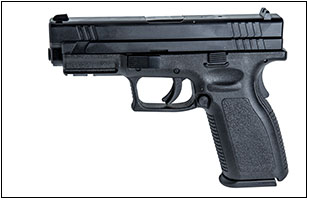Broken Gun Is Not a Deadly Weapon

The 9 mm handgun a Cincinnati juvenile had tucked in his waistband didn’t work and wasn’t used as a deadly weapon, so the teen couldn’t be found delinquent for carrying a concealed weapon.

The 9 mm handgun a Cincinnati juvenile had tucked in his waistband didn’t work and wasn’t used as a deadly weapon, so the teen couldn’t be found delinquent for carrying a concealed weapon.
A gun that does not work and is not wielded as a bludgeon is not a deadly weapon under the state law that bans carrying a concealed weapon without a license, the Ohio Supreme Court ruled today.
The Supreme Court’s decision, written by Justice William M. O’Neill, sets aside a juvenile court’s finding of delinquency against J.T., a Cincinnati teenager. A police officer had stopped J.T. and another male on the street and discovered a loaded 9 mm handgun when checking J.T.’s waistband. The gun was later found to be inoperable, though the juvenile court concluded that J.T. had been illegally carrying a concealed weapon.
The officer had been sent on March 17, 2013, to an area where a number of youth had gathered. When the officer saw J.T.’s bulging waistband, he patted down the teen and uncovered the gun. While the police complaint alleged a fourth-degree felony for carrying a concealed deadly weapon, the charge was changed before trial to a first-degree misdemeanor because the gun did not work.
A magistrate found J.T. to be delinquent for carrying the concealed weapon, and in May 2013 the juvenile court agreed. On appeal, the First District Court of Appeals affirmed the lower court’s determination.
Court’s Analysis
State law prohibits carrying an unlicensed concealed handgun or an unlicensed concealed deadly weapon. A “deadly weapon” is defined as “any instrument, device, or thing capable of inflicting death, and designed or specially adapted for use as a weapon, or possessed, carried, or used as a weapon.”
In reviewing various gun statutes, Justice O’Neill noted that the state legislature addressed operable and inoperable firearms in the law barring weapons in school zones. That statute specifically bans possession of an object “indistinguishable from a firearm, whether or not the object is capable of being fired” within school safety zones.
Justice O’Neill reasoned that the legislature also could have chosen to address inoperable weapons in the concealed weapons statute, but it did not. The court’s majority concluded state law does not allow a person to be convicted of carrying a concealed weapon when a handgun is inoperable and was not used as a bludgeon or was not used, possessed, or carried as a weapon.
“While the gun in question was no doubt designed as a weapon, the design was for the gun to shoot a projectile from the barrel at a high rate of speed,” Justice O’Neill wrote. “It was not designed to be used as a bludgeon, like a club or nightstick. The fact that the gun was inoperable means that it had lost the sole function for which it had been designed. It was no longer a deadly weapon unless there was some evidence presented that it was used as a bludgeon, or otherwise used, possessed, or carried as a weapon. There was not. Hence, it was no more of a deadly weapon than is a laptop computer or a briefcase, yet attorneys are not routinely arrested for carrying concealed weapons as they enter our courthouses.”
The court’s ruling reversed the judgment of the First District Court of Appeals.
Justices’ Votes
Joining the majority opinion were Chief Justice Maureen O’Connor and Justices Judith Ann Lanzinger and Judith L. French. Justices Terrence O’Donnell and Sharon L. Kennedy concurred only in the court’s judgment.
Justice Paul E. Pfeifer dissented and would have dismissed the appeal as improvidently allowed.
2014-0449. In re J.T., Slip Opinion No. 2015-Ohio-3654.
 View oral argument video of this case.
View oral argument video of this case.
Please note: Opinion summaries are prepared by the Office of Public Information for the general public and news media. Opinion summaries are not prepared for every opinion, but only for noteworthy cases. Opinion summaries are not to be considered as official headnotes or syllabi of court opinions. The full text of this and other court opinions are available online.
Acrobat Reader is a trademark of Adobe Systems Incorporated.


